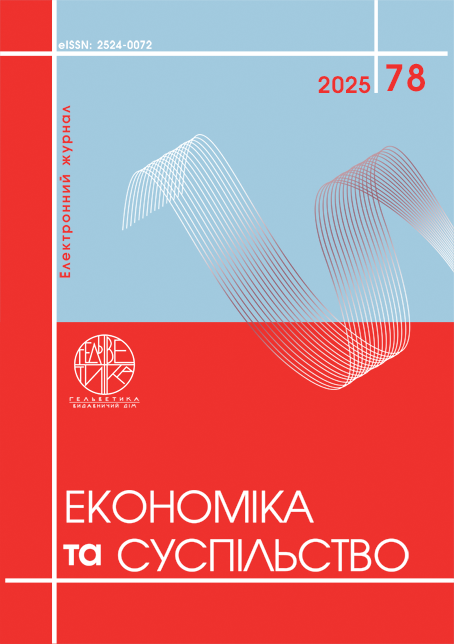QUANTITATIVE ANALYSIS OF THE EFFICIENCY OF STIMULATING INVESTMENTS IN TRADE ENTERPRISES IN UKRAINE
Abstract
This article provides a concise quantitative assessment of how investment-stimulation policy affects Ukrainian trade enterprises during a period of economic and geopolitical turbulence. Drawing on macroeconomic statistics, expert surveys, and an original composite index, the study evaluates key determinants of investment attractiveness and the real efficiency of government incentives in a sector that once generated about 45 % of national GDP but has faced a 30 % fall in foreign direct investment and a 25 % drop in merchandise trade since 2022. The research combines a review of international practice with empirical analysis. Sixty-eight experienced professionals from government, business, and civil society assessed eight groups of investment risks using a five-point Likert scale. Data were processed in Excel and SPSS with descriptive statistics, Shapiro–Wilk tests, and Student’s t-test to ensure significance. External shocks and macroeconomic instability received the highest impact scores (≈3.9), while internal managerial factors scored slightly lower but remained important. The perceived ability to manage regulatory risks was relatively high (≈3.7), indicating that state policy could meaningfully reduce barriers. Business respondents rated tax incentives and accessible credit as the most effective tools, while industrial parks or direct co-financing were viewed as less practical. Simplified permitting and digital “one-stop” services achieved the highest effectiveness ratings (around 4.2–4.3). Major obstacles include legislative volatility, opaque regulation, and limited financing—findings that mirror global evidence linking institutional quality with investor confidence. Based on normalized indicators—legal stability, tax policy, institutional strength, infrastructure, financing access, and procedural transparency—the authors developed an Investment Attractiveness Index that reached 0.55 on a 0–1 scale, reflecting only moderate appeal. The conclusion emphasizes strengthening rule of law, improving financial inclusion, and systematically evaluating fiscal incentives as priority measures to raise this index and unlock the sector’s post-war recovery potential.
References
Гринів В., Клепанчук О. Роль інвестиційних процесів у післявоєнній відбудові торговельної галузі України. Мodeling the development of the economic systems. 2023. № 2. С. 179–188. DOI: https://doi.org/10.31891/mdes/2023-8-24 (дата звернення: 25.05.2025).
Талах Ю.В. Змістові характеристики та особливості інвестиційної привабливості роздрібної торгівлі. Бізнес Інформ. 2024. № 4. C. 147–153. DOI: https://doi.org/10.32983/2222-4459-2024-4-147-153
Сазонов Р.Ю. Пріоритети стимулювання інвестицій у торгівлю України. Інвестиції: практика та досвід. 2024. № 5, С. 137–143. DOI: https://doi.org/10.32702/2306-6814.2024.5.137
Al-Smadi R.W., Al-Smadi A.W. The relationship between foreign direct investment and financial inclusion in MENA countries: Evidence from the General Method of Moments. Investment Management and Financial Innovations, 2024. № 21(2), С. 144–154. DOI: https://doi.org/10.21511/imfi.21(2).2024.11
Azémar C., Giroud, A. World Investment Report 2022: International tax reforms and sustainable investment: United Nations Conference on Trade and Development, Geneva and New York, 2022, 219 pp. ISBN: 978-9211130492. Journal of International Business Policy. 2022. № 6(2), С. 235–239. DOI: https://doi.org/10.1057/s42214-023-00148-1
Azizov M., Bilan Y., Jabiyev F., Alirzayev, E., Heyderova, A. The impact of foreign direct investment on GDP growth: The case of Turkey. Investment Management and Financial Innovations, 2023. № 20(4), 50–59. DOI: https://doi.org/10.21511/imfi.20(4).2023.05
Bruno R.L., Campos N.F., Estrin S. The Effect on Foreign Direct Investment of Membership in the European Union. JCMS: Journal of Common Market Studies. 2021. № 59. С. 802–821. DOI: https://doi.org/10.1111/jcms.13131.
Columbia Center on Sustainable Investment (CCSI). Investment incentives: A survey of policies and approaches for sustainable investment. Columbia University. 2020. URL: https://ccsi.columbia.edu/sites/default/files/content/docs/publications/ Investment-Incentives-policies-approaches-sustainable-investment-CCSI-Oct-2022.pdf (accessed April 15, 2025)
Egger P., Pirotte A., Titi C. International investment agreements and foreign direct investment: A survey. The World Economy. 2023. № 46(6). С. 1524–1565. DOI: https://doi.org/10.1111/twec.13429
Graham N.P., Huang X., Yang L. (2024). Navigating trade policy uncertainty: Conservatism in cash holding and investment. Applied Economics. 2024. № 57(13). С. 1415–1433. DOI: https://doi.org/10.1080/00036846.2024.2312265
11 Hobbs S., Paparas D., AboElsoud M. (2021). Does Foreign Direct Investment and Trade Promote Economic Growth? Evidence from Albania. Economies. 2021. № 9(1). С. 1-19. DOI: https://doi.org/10.3390/economies9010001
Katitas A., Pandya S. Investment incentives attract foreign direct investment: evidence from the great recession. Public Choice. 2024. № 200. С. 323–345. DOI: https://doi.org/10.1007/s11127-024-01158-0
Kuang S., Orbie J., Blancquaert S. (2023). The rise and fall of the EU-China Comprehensive Agreement on Investment: ‘open strategic autonomy’ in action. Journal of Contemporary European Studies. 2023. № 32(3). С. 772–786. DOI: https://doi.org/10.1080/14782804.2023.2293779
Li J., & Guo Y. (2024). The impact of energy use rights trading policy on industrial companies’ green investments: Evidence from a quasi-natural experiment in China. Energy Reports. 2024. № 12. С. 329–340. DOI: https://doi.org/10.1016/j.egyr.2024.06.020
Mataba K., Lassourd T., Readhead A., Nikièma S. Revisiting tax incentives as an investment promotion tool: Q&A for investment policy-makers. International Institute for Sustainable Development (IISD). 2023. URL: https://www.iisd.org/system/files/2023-10/revisiting-tax-incentives-investment-promotion-tool-policy-makers.pdf
OECD. “Improving transparency of incentives for investment facilitation”, OECD Business and Finance Policy Papers. 2023. № 35. OECD Publishing, Paris. DOI: https://doi.org/10.1787/ab40a2f1-en
OECD. Sustainable Investment Policy Perspectives in the Economic Community of West African States (ECOWAS). 2024. OECD Publishing, Paris. DOI: https://doi.org/10.1787/654e2de5-en
Seyfullayev İ. Institutional quality and economic growth in resource rich countries. Problems and Perspectives in Management. 2025. № 23(2). С. 51–60. DOI: http://dx.doi.org/10.21511/ppm.23(2).2025.51
Slattery С., Zidar O. Evaluating State and Local Business Incentives. Journal of Economic Perspectives. 2020. Vol. 34. № 2 С. 90-118. DOI: https://doi.org/10.1257/jep.34.2.90
UNCTAD. World Investment Report 2025: Investing in Sustainable Energy for All. United Nations Conference on Trade and Development. 2025. URL: https://unctad.org/publication/world-investment-report-2025 (accessed May 10, 2025)
Al-Smadi, R. W., & Al-Smadi, A. W. (2024). The relationship between foreign direct investment and financial inclusion in MENA countries: Evidence from the General Method of Moments. Investment Management and Financial Innovations, 21(2), 144–154. https://doi.org/10.21511/imfi.21(2).2024.11
Azémar, C., & Giroud, A. (2023). World investment report 2022: International tax reforms and sustainable investment: United Nations Conference on Trade and Development, Geneva and New York, 2022, 219 pp. Journal of International Business Policy, 6(2), 235–239. https://doi.org/10.1057/s42214-023-00148-1
Azizov, M., Bilan, Y., Jabiyev, F., Alirzayev, E., & Heyderova, A. (2023). The impact of foreign direct investment on GDP growth: The case of Turkey. Investment Management and Financial Innovations, 20(4), 50–59. https://doi.org/10.21511/imfi.20(4).2023.05
Bruno, R. L., Campos, N. F., & Estrin, S. (2021). The effect on foreign direct investment of membership in the European Union. JCMS: Journal of Common Market Studies, 59, 802–821. https://doi.org/10.1111/jcms.13131
Columbia Center on Sustainable Investment. (2022). Investment incentives: A survey of policies and approaches for sustainable investment. Columbia University. https://ccsi.columbia.edu/sites/default/files/content/docs/publications/Investment-Incentives-policies-approaches-sustainable-investment-CCSI-Oct-2022.pdf (accessed April 15, 2025)
Egger, P., Pirotte, A., & Titi, C. (2023). International investment agreements and foreign direct investment: A survey. The World Economy, 46(6), 1524–1565. https://doi.org/10.1111/twec.13429
Graham, N. P., Huang, X., & Yang, L. (2024). Navigating trade policy uncertainty: Conservatism in cash holding and investment. Applied Economics, 57(13), 1415–1433. https://doi.org/10.1080/00036846.2024.2312265
Hobbs, S., Paparas, D., & AboElsoud, M. E. (2021). Does foreign direct investment and trade promote economic growth? Evidence from Albania. Economies, 9(1), 1-19. https://doi.org/10.3390/economies9010001
Hryniv, V., & Klepanchuk, O. (2023). Rol investytsiinykh protsesiv u pisliavoiennii vidbudovi torhovelnoi haluzi Ukrainy [The role of investment processes in post-war reconstruction of Ukraine’s trade sector]. Modeling the Development of the Economic Systems, 2, 179–188. https://doi.org/10.31891/mdes/2023-8-24
Katitas, A., & Pandya, S. (2024). Investment incentives attract foreign direct investment: Evidence from the great recession. Public Choice, 200, 323–345. https://doi.org/10.1007/s11127-024-01158-0
Kuang, S., Orbie, J., & Blancquaert, S. (2023). The rise and fall of the EU-China Comprehensive Agreement on Investment: ‘Open strategic autonomy’ in action. Journal of Contemporary European Studies, 32(3), 772–786. https://doi.org/10.1080/14782804.2023.2293779
Li, J., & Guo, Y. (2024). The impact of energy use rights trading policy on industrial companies’ green investments: Evidence from a quasi-natural experiment in China. Energy Reports, 12, 329–340. https://doi.org/10.1016/j.egyr.2024.06.020
Mataba, K., Lassourd, T., Readhead, A., & Nikièma, S. (2023). Revisiting tax incentives as an investment promotion tool: Q&A for investment policy-makers. International Institute for Sustainable Development. https://www.iisd.org/system/files/2023-10/revisiting-tax-incentives-investment-promotion-tool-policy-makers.pdf
OECD. (2023). Improving transparency of incentives for investment facilitation. OECD Business and Finance Policy Papers, 35. https://doi.org/10.1787/ab40a2f1-en
OECD. (2024). Sustainable investment policy perspectives in the Economic Community of West African States (ECOWAS). OECD Publishing. https://doi.org/10.1787/654e2de5-en
Sazоnоv, R. Yu. (2024). Priorytety stymuliuvannia investytsii u torhivliu Ukrainy [Priorities for stimulating investment in Ukrainian trade]. Investytsii: Praktyka ta Dosvid, 5, 137–143. https://doi.org/10.32702/2306-6814.2024.5.137
Seyfullayev, İ. (2025). Institutional quality and economic growth in resource-rich countries. Problems and Perspectives in Management, 23(2), 51–60. http://dx.doi.org/10.21511/ppm.23(2).2025.51
Slattery, C., & Zidar, O. (2020). Evaluating state and local business incentives. Journal of Economic Perspectives, 34(2), 90–118. https://doi.org/10.1257/jep.34.2.90
Talah, Yu. V. (2024). Zmistovi kharakterystyky ta osoblyvosti investytsiinoi pryvablyvosti rozdribnoi torhivli [Content characteristics and features of investment attractiveness of retail trade]. Biznes Inform, 4, 147–153. https://doi.org/10.32983/2222-4459-2024-4-147-153
UNCTAD. (2025). World investment report 2025: Investing in sustainable energy for all. United Nations Conference on Trade and Development. https://unctad.org/publication/world-investment-report-2025 (accessed May 10, 2025)
Copyright (c) 2025 Ірина Мазур, Роман Сазонов

This work is licensed under a Creative Commons Attribution 4.0 International License.


